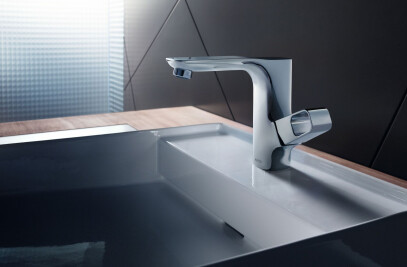When architect and designer Nina Schmid visited the very steep plot surrounded by mountains for the first time she knew instantly that she had to find a way to capture the fantastic views. The unique location of this property in the Alps should become noticeable from the outside and the inside. The two wings of the building appear like two pieces of wood. The center part of the mansion reminds of a fire, with its shimmering and sparkling appearance. It is the heart of the building: it connects the upper and lower tract. Starting from this center the whole ground plan was developed: the construction and different functions of the Kitzbuehl Mansion rely on this center. By focussing on the center and the two tracts Nina Schmid nested the Kitzbuehl Mansion perfectly into the steep slope and created fantastic new views on the mountains. In addition to the architectural planning the entire interior concept was created by splendid architecture. From custom cabinets to the cutlery - everything was either carefully handpicked or designed by Nina Schmid herself. To integrate the alpine theme throughout the house she used different materials and warm colours. She succeeded in creating a solid and warm feeling of hospitality without risking to set up a false "Cabin Fever". Architecturally, the axis and lines of sight on the Alps were the starting point for the overall planning. To understand this, one must be aware that one could not see a single mountain from the plot. Based on these lines Nina Schmid planned two wings symbolizing two pieces of wood that remind of the wintry Alps. From this idea the central part of the building was developed. The wing in the middle of the house is the heart of the building. It looks like a sparkling, dazzling fire. From this center, the outline structure was further developed. The upper part of the house lies in the east. This bar-shaped component is the residential tract. The sleeping tract is located in the west and lies in the lower part of the property. To the owners of the house it was particularly important that the house works as perfectly for two people as with many guests. Based on this consideration, the two parts of the building were divided into three levels: The bottom floor is called the guest floor: in this area the guest bedrooms are located as well as the service area with laundry room, wine cellar, etc. The middle floor is the level with the main entrance, kitchen and dining room, the terraces and the master-tract. On the top floor lies the spacious living room, the library and the spa. This has a reason: these rooms profit most from the wonderful view on the mountains. The comfort and cosiness that can be felt in every room, was created by using warm materials and colours: the oak floor is rough to the touch, there is coloured concrete-floring or goat-hair rugs. Walls are covered with wallpapers that give each room its individual character. Without neglecting the overall concept. Well selected lighting objects seem like all the art needed. Overall the architectual formulation and detailed implemention is very modern. As a tribute to the traditional Tyrolean architecture Nina Schmid used local materials inside the mansion and for the facade design. However it sometimes was adventurous to find original, old Tyrolean wood and glass to arrange and structure the facade. All these traditional materials were used in a modern way and combined with contemporary materials and modern processes. Nina Schmid indeed succeeded in creating an exciting symbiosis.
| Element | Brand | Product Name |
|---|---|---|
| Wash Basin | AXOR | |
| Coffee Table | Zanotta | |
| Standing lamp | Zeitraum GmbH |
Read Noon, Noon 2
|
| Wash Basin | Falper |
Ovale Soprapiano
|
| Washbasin | Hansgrohe SE | |
| Fireplace | Focus |
Gyrofocus
|
Project Spotlight
Product Spotlight
News

Fernanda Canales designs tranquil “House for the Elderly” in Sonora, Mexico
Mexican architecture studio Fernanda Canales has designed a semi-open, circular community center for... More

Australia’s first solar-powered façade completed in Melbourne
Located in Melbourne, 550 Spencer is the first building in Australia to generate its own electricity... More

SPPARC completes restoration of former Victorian-era Army & Navy Cooperative Society warehouse
In the heart of Westminster, London, the London-based architectural studio SPPARC has restored and r... More

Green patination on Kyoto coffee stand is brought about using soy sauce and chemicals
Ryohei Tanaka of Japanese architectural firm G Architects Studio designed a bijou coffee stand in Ky... More

New building in Montreal by MU Architecture tells a tale of two facades
In Montreal, Quebec, Le Petit Laurent is a newly constructed residential and commercial building tha... More

RAMSA completes Georgetown University's McCourt School of Policy, featuring unique installations by Maya Lin
Located on Georgetown University's downtown Capital Campus, the McCourt School of Policy by Robert A... More

MVRDV-designed clubhouse in shipping container supports refugees through the power of sport
MVRDV has designed a modular and multi-functional sports club in a shipping container for Amsterdam-... More

Archello Awards 2025 expands with 'Unbuilt' project awards categories
Archello is excited to introduce a new set of twelve 'Unbuilt' project awards for the Archello Award... More























